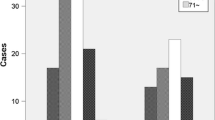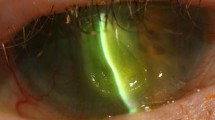Abstract
Background
Malassezia species rarely cause keratitis, and, thus, the clinical manifestations of Malassezia keratitis are not well known.
Case
We report the clinical findings in a 70-year-old woman who complained of pain in her left eye. Slit-lamp biomicroscopy showed a corneal ulcer with irregular infiltration, which resembled keratitis caused by filamentous fungi. KOH Parker ink stain of a corneal scraping showed mold hyphae and yeast, but cultures on Sabouraud's glucose agar plates and blood agar plates were negative. Treatment with antibacterial agents failed.
Observations
Polymerase chain reaction (PCR) and DNA typing of the fungal gene between the internal transcribed spacer 2 (ITS2) and the 5.8S ribosomal DNA of the scraping were performed. PCR amplified a band with a sequence that was 99% homologous with Malassezia restricta. Antifungal agents, topical 5% pimaricin ointment and 0.2% miconazole, and oral itraconazole 150 mg/day, were applied, and the corneal ulcer disappeared within 5 weeks.
Conclusion
Malassezia restricta can cause keratitis, and the clinical findings resemble keratitis caused by filamentous fungi. PCR and DNA typing of ITS2 and 5.8S ribosomal DNA are valuable techniques for detecting and identifying Malassezia species. Proper identification of Malassezia keratitis permits a prompt and successful treatment by antifungal agents. Jpn J Ophthalmol 2007;51:292–294 @ Japanese Ophthalmological Society 2007
Similar content being viewed by others
References
C Ferrer F Colom S Frases E Mulet JL Abad JL Alio (2001) ArticleTitleDetection and identification of fungal pathogens by PCR and by ITS2 and 5.8S ribosomal DNA typing in ocular infections J Clin Microbiol 39 2873–2879 Occurrence Handle11474006 Occurrence Handle10.1128/JCM.39.8.2873-2879.2001 Occurrence Handle1:CAS:528:DC%2BD3MXmsVOmsro%3D
J Toth M Bausz L Imre (1996) ArticleTitleUnilateral Malassezia furfur blepharitis after perforating keratoplasty Br J Ophthalmol 80 488 Occurrence Handle8695578 Occurrence Handle1:STN:280:BymB2szlvVI%3D
J Roodhooft G van Rens M Bogaerts JM Vermander (1998) ArticleTitleInfectious crystalline keratopathy: a case report Bull Soc Belge Ophtalmol 268 121–126 Occurrence Handle9810093 Occurrence Handle1:STN:280:DyaK1M%2FislOrug%3D%3D
M Garau M Pereiro SuffixJr A del Palacio (2003) ArticleTitleIn vitro susceptibilities of Malassezia species to a new triazole, albaconazole (UR-9825), and other antifungal compounds Antimicrob Agents Chemother 47 2342–2344 Occurrence Handle12821494 Occurrence Handle10.1128/AAC.47.7.2342-2344.2003 Occurrence Handle1:CAS:528:DC%2BD3sXltFehtbs%3D
Author information
Authors and Affiliations
Corresponding author
About this article
Cite this article
Suzuki, T., Hori, N., Miyake, T. et al. Keratitis Caused by a Rare Fungus, Malassezia restricta . Jpn J Ophthalmol 51, 292–294 (2007). https://doi.org/10.1007/s10384-007-0447-0
Received:
Accepted:
Published:
Issue Date:
DOI: https://doi.org/10.1007/s10384-007-0447-0




